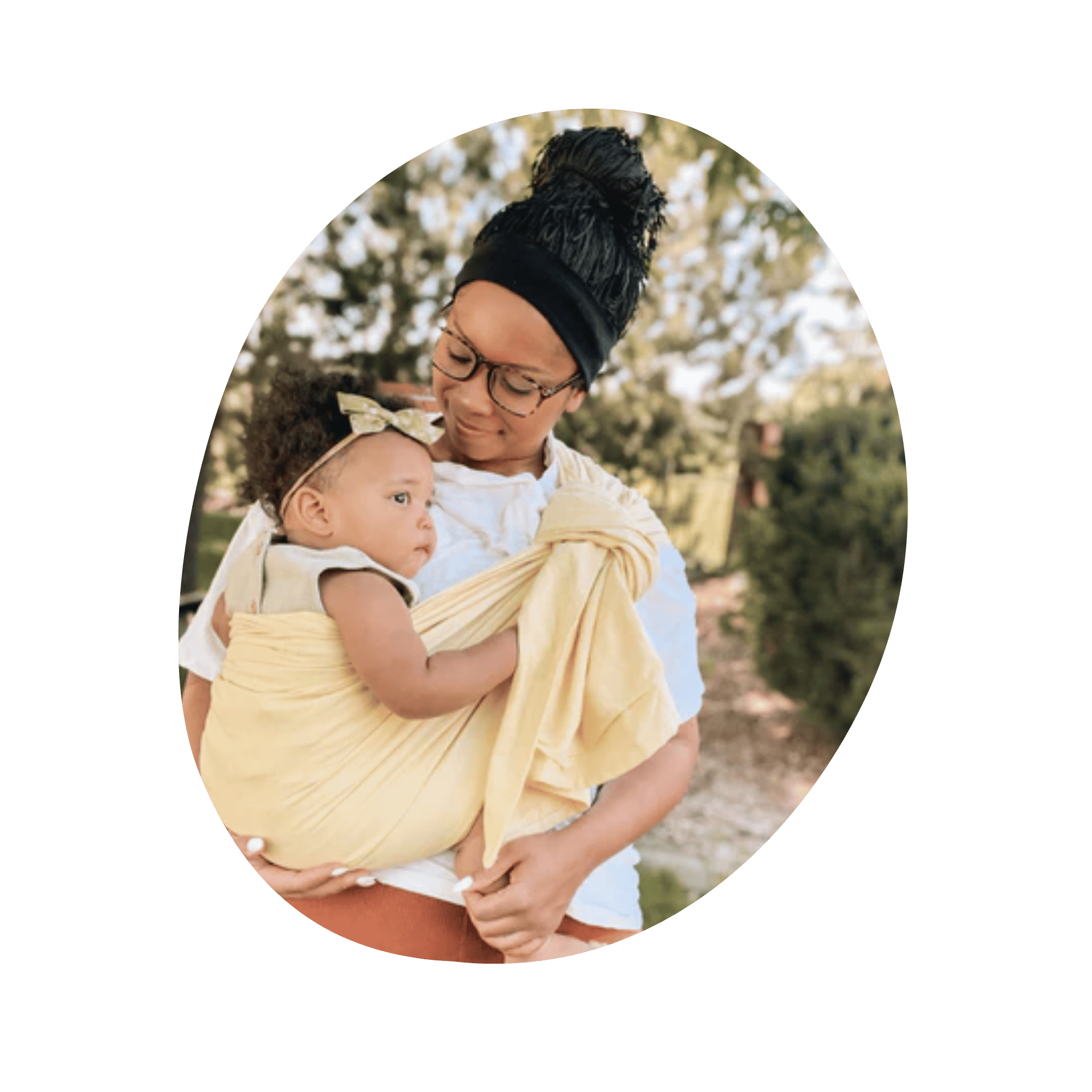Sweet Dreams + Cozy Cuddles: Babywearing Helps Healthy Sleep
In households across the world blessed with a new baby, the question of sleep becomes a central issue of the family’s daily life. Is my baby getting enough sleep? How do I get my baby to sleep? Will I ever sleep again? Sleep is so important, and many of us don’t know that until we can no longer bask in the benefits of a good night’s sleep. But did you know that baby carriers can help? Let’s take a look at how baby carriers and sleep can go hand in hand and, most importantly, make sure safety is our top priority!
Skin-to-Skin → Contact Naps
In the first moments after birth, many babies are placed on their parent’s chest for skin-to-skin contact, and this particular type of closeness is recommended throughout baby’s first few months. The benefits of these early cuddles are numerous: “It can promote bonding and the release of feel-good hormones, for example. It can also help regulate your baby's body temperature and heart rate…[and allow for more] time spent in the deep sleep and quiet alert states” (American Academy of Pediatrics, 2024). Although direct skin-to-skin may not be realistic to continue for months after birth – hello winter babies and going out in public – babies and caregivers can still reap many of these benefits through contact naps.

Contact naps are just what they sound like – baby sleeps while directly touching their caregiver, usually on their chest. “Contact naps can be great at getting an unsettled baby to sleep quickly – when your baby is close to you, they’ll almost instantly re-settle!” (Golshevsky, 2024b).
New babies are confused by the world they’ve been abruptly introduced to. It’s loud, it’s bright, and it’s cold. But contact naps help baby to feel your heartbeat and your warmth, and this helps to downplay some of the other more unseemly inputs they're getting and helps them stay asleep longer. Contact naps lead to “babies linking sleep cycles and getting nice long stretches of sleep so they wake hungry for better feeds, thereby accessing all the calorie-dense hind milk” (Golshevsky, 2024a).
While a baby sleeping in their crib or bassinet may wake up without the tools to self-soothe, prematurely ending what could have been a great nap, a baby who wakes during a contact nap is immediately tuned into their caregiver’s scent, pulse, and snuggles and can more easily fall back to sleep. Plus, their caregiver is there and can quickly start swaying, shushing, and patting baby’s bottom to encourage them back to sleep. This well-rested baby then has longer wake windows where they can reap the benefits of longer feedings, interacting with their caregivers, and taking in the world around them.
The only "problem" with contact naps is the dreaded nap-trap. It’s all cute and cozy until your phone dies, you notice you’re suddenly the thirstiest you’ve ever been, or you have to pee. Enter the baby carrier.

Benefits of Babywearing Naps
Babywearing naps give all the benefits of a contact nap while also allowing you to be handsfree and mobile. No longer are you tethered to the couch with a baby in your arms. “I favour carriers rather than your baby sleeping directly on you (which they love) because you have your arms and legs free, allowing freedom of movement, improving both your physical and mental well-being” (Golshevsky, 2024a).
Once you unlock the baby carrier nap, baby can nap anywhere and be just as comfy and cozy as when being held in your favorite chair at home. Do you have chores to do but baby is sleepy? Babywearing nap. Do you need to grab the groceries, but you’re not sure if baby will hit a tired wall and need a nap in the middle of aisle 3? Babywearing nap. Are you simply having too good a time at brunch to have to bring that sleepy baby home? Babywearing nap. Seriously. It is the answer to the question, “How do I get it all done?”

Staying Safe while Sleepy
As with all things babywearing, we want to make sure we make safety our top priority. So how do we make sure we’re staying safe while sleeping in a baby carrier? Simply put, just follow the same tips for getting a safe fit in the carrier while awake and baby should be safe to sleep as well. While baby is sleepy or sleeping, follow T.I.C.K.S.:
-
T - Tight carrier with no loose fabric
-
I - In view
-
C - Close enough to kiss
-
K - Keep chin off chest
-
S - Supported back
This means if you lowered baby to feed them before they fell asleep, it is very important to bring baby back up to a tight, supported position where baby is close enough to kiss. If you’re worried about waking baby up, you can add in a bounce, sway, and shush while you’re tightening them back up. Throw in a few butt pats, and they should fall right back to sleep to take a close, cozy nap.
As for you, you should never sleep while babywearing. Don’t lie down – if you do, baby is no longer safe and upright in the carrier. Sitting and resting in a chair is fine. If you feel yourself nodding off, choose an activity to keep yourself awake throughout your baby’s carrier nap. If that’s still not working, get up and move around.
Remember that baby’s face should always be in view. If you’re asleep, you’re no longer monitoring baby. If you’re able to, hand baby off to another caretaker or put baby down in a safe place so that you can also get some shuteye. Getting enough sleep when you have an infant, baby, or toddler can be challenging. We all should make “...sufficient sleep a family priority. Understand the importance of getting enough sleep and how sleep affects the overall health of you and your children” (American Academy of Pediatrics, 2019).
It seems counterintuitive, but helping baby nap better during the day allows them to approach bedtime without being overtired, which in turn allows them to sleep better at night, improving sleep health for your whole family.

Babywearing as Part of Your Sleep Routine
If you’ve had more than one child or your sleepy infant is now a sitting, crawling, cruising baby on their way to toddlerhood, you may balk at the idea of babywearing naps. Sure, it’s great for those little snoozes during infancy when they weigh almost nothing. But what about when they’re down to one, long nap each day, and they feel like a ton of bricks? You may be thinking that babywearing and sleep just do not go together for you anymore. But you can still incorporate babywearing into your bedtime routine.
Bedtime routines are important for babies and kids. Heck, even adults would do better with a consisted bedtime routine! “As was expected, children fell asleep faster following the institution of the consistent bedtime routine, and…sleep throughout the night also improved, including a decrease in the number and duration of night wakings…” (Mindell et al., 2009).

As part of your routine, you can wear your baby and go on a walk, bounce on an exercise ball, or simply sway and hum. The closeness of a snug and secure carrier allows baby to feel warm and safe. They can more easily regulate their breathing, heart rate, and body temperature. They will be more relaxed and able to drift into dreamland.
Even toddlers can benefit from babywearing as part of their bedtime routine. A slow and steady babywearing walk while your toddler is in a back carry allows you two to be closer and more connected than when they’re running around and causing chaos. You can have little conversations, check in about their day, or tell them a story. They’ll be ready to transfer and sleep soundly.
There are so many ways to incorporate babywearing into your family’s healthy sleep routines. As long as you’re prioritizing safety, you can’t go wrong when adding baby carriers to your baby sleep toolbox. Tag us with the way babywearing helps your baby (and family!) sleep.
Summary
Contact naps support better sleep: Skin-to-skin contact and contact naps help regulate a baby’s body and support longer, deeper sleep.
Babywearing naps are freeing and effective: They offer the same comfort as contact naps while allowing caregivers to move, multitask, and stay hands-free.
Safety is key: Follow the T.I.C.K.S. guidelines (Tight, In view, Close enough to kiss, Keep chin off chest, Supported back) to ensure baby sleeps safely in a carrier.
Never sleep while babywearing: Adults must stay awake and alert while babywearing; transfer baby to a safe space if needed.
Use babywearing in bedtime routines: Wearing baby before naps or bedtime—through walks, bouncing, or swaying—helps soothe and transition them to sleep, even as toddlers.
References
American Academy of Pediatrics. (2019). Healthy sleep habits: How many hours does your child need? HealthyChildren.org. https://healthychildren.org/English/healthy-living/sleep/Pages/Healthy-Sleep-Habits-How-Many-Hours-Does-Your-Child-Need.aspx
American Academy of Pediatrics. (2024, February 2). About skin-to-skin care. HealthyChildren.org. https://www.healthychildren.org/English/ages-stages/baby/preemie/pages/About-Skin-to-Skin-Care.aspx
Golshevsky, D. (2024a, June 25). Dr golly on why he loves baby carriers and baby wraps. Dr Golly. https://drgolly.com/baby-carriers-and-baby-wraps/
Golshevsky, D. (2024b, August 5). Contact napping newborn. Dr Golly. https://drgolly.com/contact-napping-newborn/?srsltid=AfmBOopJXSzsl25Gyu_MunmXL0VS1cxx56CNOEq3ue-EApJvHcLO7NwX
Mindell, J. A., Telofski, L. S., Wiegand, B., & Kurtz, E. S. (2009). A nightly bedtime routine: Impact on sleep in young children and maternal mood. Sleep, 32(5), 599–606. https://doi.org/10.1093/sleep/32.5.599





